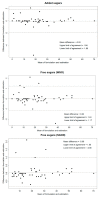A Disaggregation Methodology to Estimate Intake of Added Sugars and Free Sugars: An Illustration from the UK National Diet and Nutrition Survey
- PMID: 30154337
- PMCID: PMC6164377
- DOI: 10.3390/nu10091177
A Disaggregation Methodology to Estimate Intake of Added Sugars and Free Sugars: An Illustration from the UK National Diet and Nutrition Survey
Abstract
Various and inconsistent definitions for free and added sugars are used in the consideration and assessment of dietary intakes across public health, presenting challenges for nutritional surveillance, research, and policy. Furthermore, analytical methods to identify those sugars which are not naturally incorporated into the cellular structure of foods are lacking, thus free and added sugars are difficult to estimate in an efficient and accurate way. We aimed to establish a feasible and accurate method that can be applied flexibly to different definitions. Based on recipe disaggregation, our method involved five steps and showed good repeatability and validity. The resulting Free Sugars Database provided data for seven components of sugars; (1) table sugar; (2) other sugars; (3) honey; (4) fruit juice; (5) fruit puree; (6) dried fruit; and (7) stewed fruit, for ~9000 foods. Our approach facilitates a standardized and efficient assessment of added and free sugars, offering benefit and potential for nutrition research and surveillance, and for the food industry, for example to support sugar reduction and reformulation agendas.
Keywords: added sugars; dietary recommendations; food composition; free sugars; ingredients; method; nutrition survey; recipe analysis; sugars.
Conflict of interest statement
The authors declare no conflict of interest.
Figures



References
-
- Fidler Mis N., Braegger C., Bronsky J., Campoy C., Domellof M., Embleton N.D., Hojsak I., Hulst J., Indrio F., Lapillonne A., et al. Espghan Committee on Nutrition. Sugar in infants, children and adolescents: A position paper of the European Society for Paediatric Gastroenterology, Hepatology and Nutrition Committee on Nutrition. J. Pediatr. Gastroenterol. Nutr. 2017;65:681–696. doi: 10.1097/MPG.0000000000001733. - DOI - PubMed
-
- Scientific Advisory Committee on Nutrition (SACN) Carbohydrates and Health. Public Health England; London, UK: 2015.
-
- World Health Organisation (WHO) Guideline: Sugars Intake for Adults and Children. WHO; Geneva, Switzerland: 2015. - PubMed
-
- Imamura F., O’Connor L., Ye Z., Mursu J., Hayashino Y., Bhupathiraju S.N., Forouhi N.G. Consumption of sugar sweetened beverages, artificially sweetened beverages, and fruit juice and incidence of type 2 diabetes: Systematic review, meta-analysis, and estimation of population attributable fraction. BMJ. 2015;351:h3576. doi: 10.1136/bmj.h3576. - DOI - PMC - PubMed
MeSH terms
Substances
Grants and funding
LinkOut - more resources
Full Text Sources
Other Literature Sources

